-
Oil Mist In The Food Production Industry
We all know how the industrial food production is on a steep rise. But, as much as we love our food, it’s also crucial to note that the demands and emissions associated with industrial food systems can affect workplace safety and the environment. A food production industry that encompasses dairy, seafood, sugars, bakery, grain/seed milling, animal feed, fruit preservation, meat products, drinks, and sugars has a wide range of air quality and emissions problems. Because of the equipment utilized, the facility’s layout, and the types of products used in food production, each form of food production generates different kinds of emissions. And if this was not enough, regulations regarding the environment, public health, and safety add to the difficulty by limiting production and increasing the demand for mitigating actions.
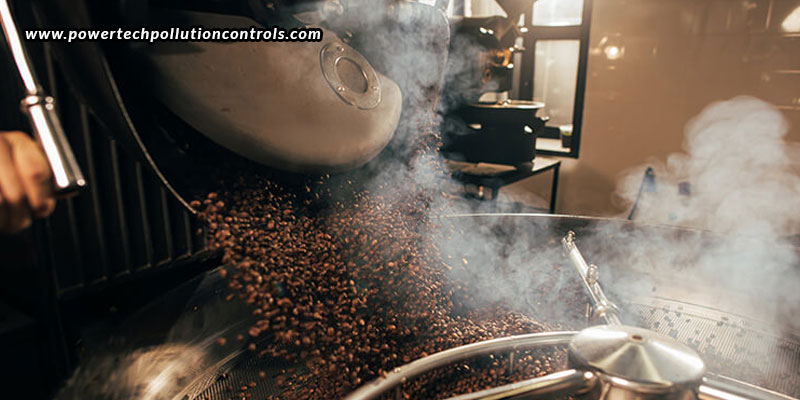
Pizza
Everyone enjoys the scent of freshly baked pizza. However, making pizza in commercial quantities has its own challenges. For instance, olive oil is employed in the making of pizza. This action causes olive oil mist to be dispersed in the area, increasing the danger to quality, equipment, and health hazards.
Pies
Oil mist is a problem in industrial food production for baked items like pie. Majority of frozen or baked items today offer a “no stick” promise or feature to provide the client with additional ease. To do this, pressurised oil must be sprayed into the container to line the baking sheet or crust tray. Due to the spray’s high concentration, the production facility’s surroundings are frequently exposed to fine oil spray mists, which might result in unfavourable health and safety issues or the formation of films on the equipment.
Bagels
The distinctive flavour of bagels is due to the sourdough recipe that includes malt, eggs, and honey. The wood-fired ovens used to make the bagels are a defining feature and a major flavour contributor, but they also have significant negative effects on the environment and human health. The smoke produced by burning wood at standard cooking temperatures contains a variety of harmful substances, such as benzene, formaldehyde, acrolein, and polycyclic aromatic hydrocarbons. Inhalation of these chemicals causes respiratory issues and may set off an asthma attack. Other occupational health problems caused by exposure can include things like itchy eyes.
There is little room for error in the food manufacturing industry, and space for personnel and equipment is frequently at a premium. However, it is crucial to combat the aforementioned oil mist. For this reason, if your company involves any form of food manufacturing, you must always install an oil mist collector. The baked delicacies mentioned above are only a few of the most widely consumed foods. But practically every type of food preparation uses a working element of some sort that, when heated, might create a dangerous mist. So, if you haven’t already, contact Powertech Pollution Controls right away to gain access to the best oil mist collector for your food manufacturing facility. The Mistkiller can be used to collect and control the oil mist formed within your premises.
For more information, visit: https://www.powertechpollutioncontrols.com/
-
Metal Coatings – Increasing The Danger Of Welding Fumes
Welding fumes comprise of the oxides of the metals in the materials being welded. These metal oxides, which are released during welding, can bring about a number of health dangers to the welder and those around, if there is no protection by personal protective equipment, or inadequate ventilation and fume removal systems. This is why it is recommended that there is proper ventilation in the welding workspace, and a welding fume extractor India installed. also, every welder is advised to wear personal protective gear like goggles, face masks, leather gloves, leather shoes, and more.
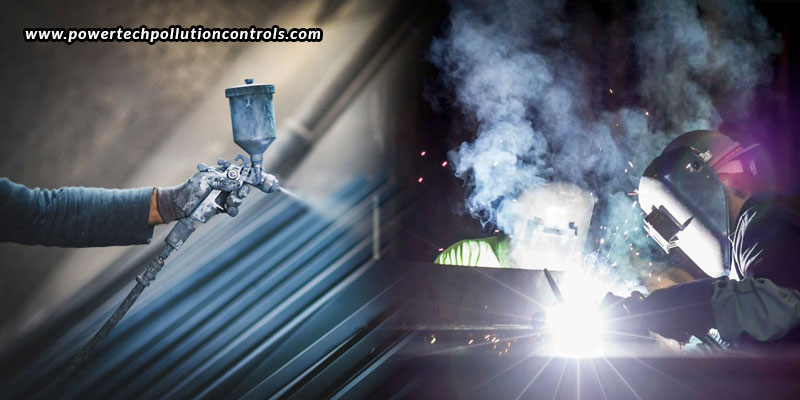
Metals producing hazardous fumes
Different flux compositions, which can result in bodily complaints and serious diseases, are to blame for the risks. Here are a few examples of welding fume compositions –
- Steel welding produces iron, along with minor levels of other metals like chromium, nickel, manganese, molybdenum, vanadium, titanium, cobalt, and copper
- Stainless steel welding produces chromium or nickel, along with iron
- Nickel alloys produce nickel and iron
- Silica or fluoride-containing fluxes produce amorphous silica, metallic silicates, and fluoride fumes
Metal coatings posing more danger
If the metal itself wasn’t enough to cause so much harm, the additional coatings over the metals can pose even more threat to the welder, and those in the vicinity. When welding a coated metal or a metal with residues, the fumes can be much more hazardous. Some such harmful coatings or residues include oils, metalworking fluids, rust preventatives, cadmium plating, plastic coating, paint coating, zinc coating, and lead oxide primer coating.
Taking off the coatings first
When any of the extra elements mentioned above are present, the metal particles and metallic oxide combine with them, lingering in the air for several hours. It is thus advised to clean the air before, during, and after the welding process. Also, it is recommended to remove all the coatings and residues before beginning the welding process. Removing the coatings will not only reduce the dangers during and after welding, but will also enhance the welding quality itself. Special products can be used for stripping off these coatings, or wet slurry vacuum removal procedures may be used. It is important to adhere to the recommended safety precautions, and put on the required personal protective equipment during the coating removal process, based on risk assessments, manufacturer’s guidelines, and potential exposures.
As you can see, welding fume is a composition of a variety of metallic oxides, fluorides, and silicates. So, it is very important to get rid of all the coatings and residues, keep the space well-ventilated, and wear protective gear while performing the welding procedure. But, at the same time, it is also important to install a genuine welding fume extractor India within the premises, which can constantly eliminate any welding fumes being generated. One fine example is the Fumekiller from Powertech Pollution Controls, which is a high-efficiency two-stage electrostatic precipitator, combined with electrostatic filtration technology, designed to capture and control fumes, mist, smoke, and fine dust produced by welding, soldering, and other similar processes.
For more information, visit our website: https://www.powertechpollutioncontrols.com/
-
Determining The Performance Of An Oil Mist Collector
Realizing the fact that oil mist filtration is certainly important, you’ve finally decided on purchasing an oil mist collector. That’s one great decision made. But, how do you know what kind of mist collector to purchase? How would you be able to determine the performance and efficiency of the mist collector? Worry not! Listed below are a few factors that characterize the performance of a mist collector. So, go through the blog below and find yourself being able to make a worthwhile decision while purchasing your oil mist collector.
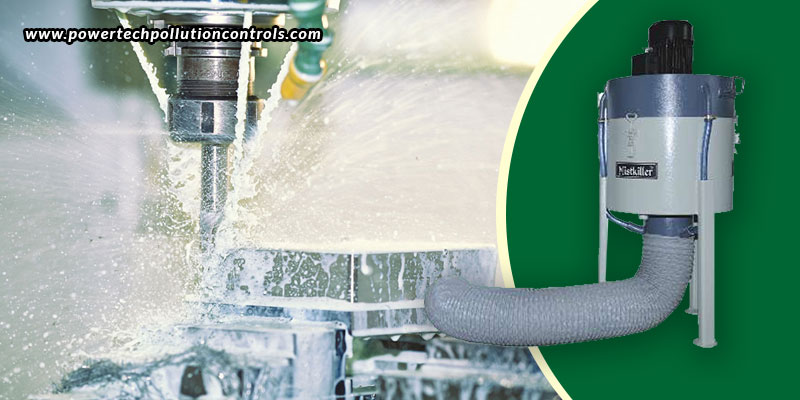
Pressure drop
In the energy cost equation, the operational pressure drop of the collector is crucial since higher pressure drops mean more energy is needed to draw the necessary airflow through the collector.
Efficiency
Installing a mist collector is done for the purpose of purifying the air. The primary indicator of how much cleaner the air will be when it leaves the collector is efficiency. Because it affects how clean the air will be after it leaves the collector and is normally vented to the indoor environment, the efficiency of the collector in eliminating mist and smoke droplets from the airstream is crucial.
Air flow
The amount of air that will be cleaned depends on the flow rate of the collector. Less mist- or smoke-laden air will be drawn through the collector if the flow is too low, which will prevent the system from capturing it. When the flow rate is too high, extra air is drawn through the collector, wasting energy. For ensuring continuous droplet capture efficiency, an airflow rate that is constant is thus preferred.
Type and amount of mist generated
The surface tension and viscosity characteristics of various mist droplet types will affect a mist collector’s capacity to coalesce and drain the mist. In addition, if a mist is clean, it won’t contain any dry particles, thus the only things we have to worry about are the liquid coalescing and draining. On the other hand, dirty mist may contain a portion of dry particles that need to be separated from the airstream. Also, depending on the application, a volume of air can include a variety of different amounts of mist. Based upon the type and amount of mist that is produced, the efficiency and performance of the mist collector will vary.
Mist temperature
Condensation can happen as hot mist cools, which might change droplet size and collection methods. Smaller droplet sizes are produced when water-based coolants evaporate at higher temperatures and lower relative humidity levels. When choosing a mist or smoke collecting method, it’s also vital to take the operating temperature restrictions of the filter medium into account.
Depending upon the above 5 factors, the performance and efficiency of a mist collector can be determined. However, for the best results, in almost any kind of application, the oil mist collector from Powertech Pollution Controls is recommended. Trademarked under the name Mistkiller, this piece of equipment is a high-efficiency centrifugal mist collector that is designed, developed, and manufactured for the control of most types of mist, generated by the use of water-based coolants or water-based liquids.
-
Three Factors That Influence A Mist Collector’s Performance
A high-efficiency mist collection system designed for your particular application is the best engineering control to keep your space secure and your business in compliance with the necessary regulations. The main function of a mist collection system is to filter out mist and smoke particulate from the filtered airstream. A mist collector must do this by combining small drops into larger ones and removing the gathered coolant from the filters before they clog. However, before investing in one such oil mist collector, it is crucial to take into account the three variables that can influence its performance.

Pressure
High-pressure coolants are advised by the majority of machine tool manufacturers because they have few additives and clean the components as they are being machined. Operators use less material because these coolants are supplied directly through the machine at high pressure. However, because of the intense pressure, the water molecules disintegrate, resulting in a large number of tiny mist droplets. It can be extremely challenging to control such large number of tiny drops. On the other hand, low-pressure machining generates bigger coolant droplets that are simpler to filter. Pressure is therefore a crucial factor to take into account when choosing the collector for your application. Also, the operating pressure drop of the collector has an impact on the amount of power needed to draw the required airflow through the unit. The greater the pressure drop, the more energy will be needed to run the unit.
Filtration efficiency
The mist collector’s ability to remove droplets from the airstream is gauged by its filtration efficiency. This is significant because it establishes how frequently the filters must be changed. Additionally, if you choose the incorrect filter for your application, it may clog up while in use, reducing airflow to the mist collector. Thereby, mist is released into the atmosphere and emission concentration increases when the door is opened in between cycles. Mist will pass through the primary filtration and saturate the secondary filter if the incorrect filter is being used, reducing airflow and eventually decreasing filtration efficiency. It is thus important in high-volume production to use multi-stage filtering that self-cleans during operation by optimizing the drainage of the separated coolant. Additionally, you must choose the appropriate filter material for your particular droplet spectrum.
Airflow
The size of the machine tool enclosure and the number of times it is opened decides on the amount of airflow. You require a lot more airflow if the doors are big, or are opened every 25 seconds as opposed to every 30 minutes. It’s crucial to maintain a negative pressure inside the machine enclosure. The moment the doors open, a rush of outside air pushes the mist away from the operator’s breathing zone. But, if adequate airflow isn’t maintained, the mist may escape. The effectiveness of an air collector depends on its airflow rate because it determines how much mist or smoke-laden air will be drawn through. Less polluted air will reach the system and not be cleaned if the flow is too low. On the other hand, high flow rate will waste energy by needlessly drawing in more clean air. Thus, a steady airflow rate must be maintained to provide stability for efficient droplet capture.
Considering these three factors, you should be in a better position to choose your oil mist collector. One suggestion is the Mistkiller from Powertech Pollution Controls, which is a high-efficiency centrifugal mist collector, designed and developed for the control of most types of mist, generated by the use of water-based coolants or water-based liquids. This mist collectors can be effectively used in a variety of industries and applications like CNC machining, non-CNC machining, cleaning chambers, spraying systems, and more.
-
Oil Mist – The Dangers And Prevention
Oil mist is a common problem in many industrial and manufacturing workplaces that involve the usage of oil, which can be hazardous for the health of the workers within the premises. oil mist is created when oil lubricates the parts in a machinery, breaking down into small droplets that float in the air. When these tiny droplets are inhaled by workers, it causes lots of health problems.
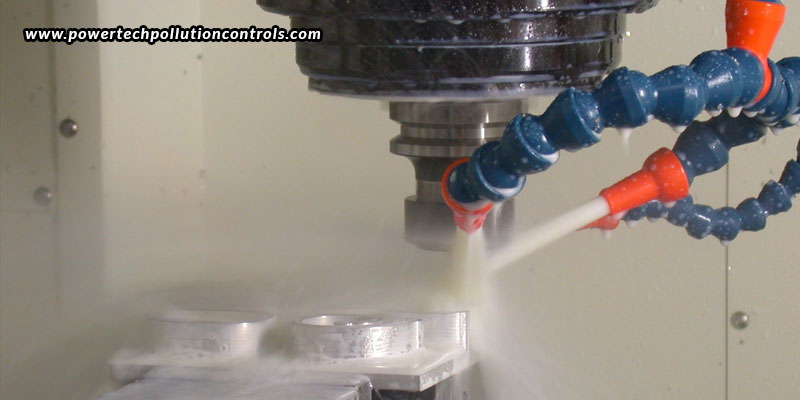
Dangers of oil mist
Oil mist, which is caused by the vapourization of the cooling lubricant around rotating tools, or the condensation of vapourized cooling lubricant on warm surface, coats all the machineries around. Long-term or repeated exposure to such mist proves to be harmful for health. Workers who are exposed to it are at a very high risk of developing skin disorders, respiratory problems, occupational asthma, bronchitis, or any other such respiratory tract irritation or breathing difficulties. It is thus your duty, as an employer, to reduce the oil mist within your workplace at the earliest!
How to control oil mist?
There are many ways to reduce oil mist in the workplace, one way being to install an oil mist collector, which is a device that removes oil mist from the air, using filters. When choosing an oil mist collector, it is important to consider the size of machine you are using, and the type of mist being generated within the space. Let’s look at these aspects in detail.
- Type and size of the machine – The size of your machine can let you know the size of the mist collector you need. A small machine can need only a smaller mist collector, while the larger the machine, the larger the collector you’ll need.
- Type of oil mist generated – There are two main types of oil mist that can be generated, namely oil-based and water-based. Water-based oil mist is easier to collect, but difficult to remove from the air. Oil-based oil mist is, on the other hand, difficult to collect, but easy to remove from the air.
- Type of oil mist collector – There are two types of oil mist collectors, namely cartridge and cyclonic. Cartridge collectors are more effective and expensive, while cyclonic collectors are affordable, but not as effective in performance.
Choosing your mist collector
Choosing the right mist collector is important. With the right mist collector, you’ll be able to keep your machine running smoothly and efficiently. Also, the health of your workers will not be compromised while they’re working for you, which means a happy healthy environment for them. Powertech Pollution Controls offers a high-efficiency oil mist collector, under the trademarked name Mistkiller, which is designed and developed to control most types of mist, generated by the use of water-based coolants or liquids. It works primarily on the principle of high-speed centrifugal collection of liquids. Compared to other types of filters, its efficiency is high, with the maintenance and running costs being quite low; thus an added benefit for you. Contribute to a safer and healthier work environment for your workers by installing the Mistkiller!
-
How Do Oil Mist Collectors Operate?
Oil mist is a common by-product of the manufacturing process in industries. This mist could cause issues for both the personnel and the equipment. Also, it might damage the equipment and create a risky working environment. Yet there is a solution for this problem, and it is referred to as an oil mist collector. When it comes to removing the oil mist from the air, these tools can be quite useful and highly efficient. This blog article will go over how oil mist collectors work and why manufacturers must have them.
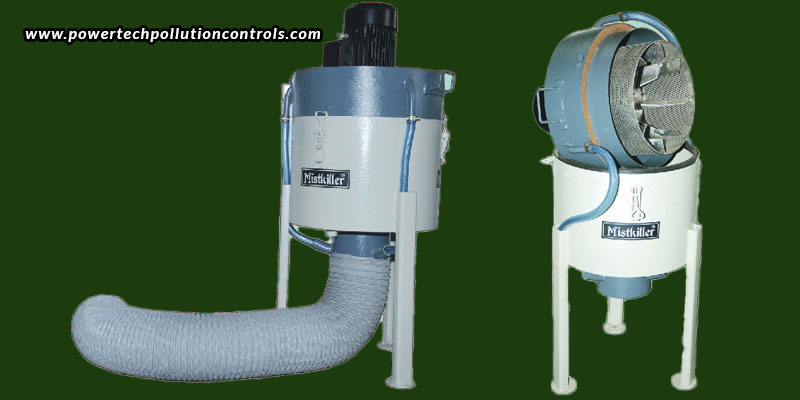
How do oil mist collectors operate?
Many mist collectors make use of centrifugal technology, in which a rotating drum traps unwanted particles and combines them into larger droplets that eventually drain out the unit. Fine mist particles cannot be separated using this technique, though. For better outcomes, such systems are thus frequently enhanced with a post-filter. However, these post-filters might have a shorter lifespan, which results in less airflow. Also, t hese filters require constant maintenance to keep the mist collectors operating well, which results in significant expenditures. Oil mist collectors should hence be positioned as close to the mist’s source as is possible. This will increase the collector’s efficiency while also assisting in the reduction of oil mist production.
The results of an oil mist collector
Employees are at risk from oil mist because it can cause respiratory ailments. The use of oil mist collectors can make the workplace safer for the workers. Moreover, oil spray can harm equipment and make it unreliable. You can safeguard your investment and maintain the efficiency of your machinery with oil mist collectors. Your machinery will thus last longer and require lesser maintenance. This implies that over time, you’ll save money.
Which applications can an oil mist collector be used in?
Metalworking industry – The metalworking industry is the one that uses oil mist filtering equipment the most because metals, when milled or ground, can produce a variety of vapours and mist that can be extremely hazardous to anyone present. Moreover, the mist can transform into an offensive-smelling smoke that is even more hazardous if a high temperature is involved.
HVAC industry – Have you realized that there are dangerous particles in the air inside your house and workplace as well? Are you aware that indoor air pollution can be up to five times higher than outdoor air? For this reason, mist collectors are a common component of HVAC systems.
Food and beverage industry – There is a lot of smoke, oil, and other debris in the food and beverage industry. Because of this, installing a mist collector helps reduce the danger of contamination while maintaining quality, and making the workplace safer and healthier for the workers.
Art industry – The painting and woodworking industries produce a lot of hazardous materials and release them into the air. Oil mist collectors can assist in this situation by gathering these particles, which can then be recycled and reused, improving both the air quality and minimizing waste.
Oil mist collectors can undoubtedly be a very useful tool for any company that uses oil in any form in its machinery. The Mistkiller oil mist collector from Powertech Pollution Controls may be the best choice if you want to enhance your working environment and safeguard your investment.
-
Installing An Extraction Arm Within Your Workplace
An arm system is a special installation utilised in the workplace to extract fumes from a line of welding booths, together with welding extraction systems. Before the contaminant can enter the worker’s breathing zone, an extraction arm can catch aerosols or any other airborne pollutants at the emission site. The suction hood can be placed with complete ease and flexibility directly at the source of the fume generation, capturing fumes close to the source to prevent them from spreading throughout the workplace and negatively harming everyone who works there. Installing several arm systems at your workspace allows you to autonomously position each arm so that it is close to each welding fume source.
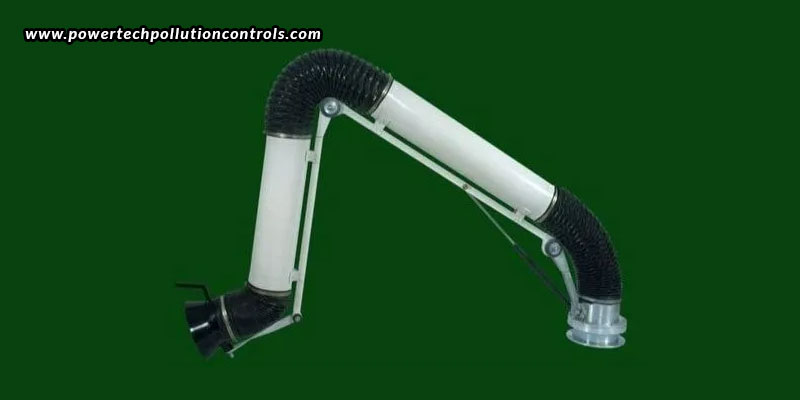
Which industries may require such extraction arms?
Extraction arms are available in a range of lengths and radiuses, to suit individual applications. The versatility of such systems and their configurations make them ideal for where work is done in predefined spaces, as well as for larger installations, where workpieces may vary greatly in size. The common industries and applications for such extraction arms include aluminium welding, steel welding, copper alloy welding, magnesium welding, nickel welding, buffing, polishing, core grinding, drilling, soldering, screen printing, pesticide manufacturing, plastic manufacturing, resin manufacturing, rubber manufacturing, soap manufacturing, animal food manufacturing, food packaging plants, jewellery manufacturing, chemical laboratories, forensic laboratories, electronics assembly lines, heavy equipment repairing shops, vehicle service shops, and many others.
Where can you get the best extractor arm?
One of the finest extractor arm you can choose to install is that which is manufactured by Powertech Pollution Controls, which is a highly useful accessory that is used with the most popularly used welding fume extractor India, trademarked as the “Fumekiller”. The extractor arm consists of two ducts made of aluminium or stainless steel, connected by flexible PVC hoses, and mounted on interconnected support rods with friction-loaded pivots. One end holds a suction hood, while the other being attached to a rotating hollow cylinder. The suction hood, the ducts, the host, and the rotating cylinder form a passage for the fumes that are to be removed. The suction hood can be moved manually 2 to 4 metres to the left or right, up or down, depending on the requirement. This system’s operating and maintenance costs are comparatively very low because every component is designed for dependable, secure, and effective use. By removing harmful airborne contaminants, these systems help create a safer and healthier working environment at a very low cost.
Criteria to consider before installation
It is crucial that you take into account a few fundamental factors before buying an extraction arm. The configuration of the extraction system you’ll require depends on a number of factors, including the processes you use, their intensity, how quickly contaminants build up, what kinds of contaminants they produce, how quickly airflow must move through the system to capture them, and the physical restrictions or protocols of your facility, such as its size, capacity, number of employees, internal pressure and temperature, etc. Before choosing a certain type of extraction system for your workplace, it is better to speak with an expert and go over all of these factors.
-
Student Safety In Welding Schools
Welding happens not only in workshops and manufacturing facilities, but also in other places like welding school and educational facilities. You can understand how bad the problem is when young students are exposed to such pollutants, as there is already enough concern about the toxic welding fumes and gases generated from the operations when adults work in workshops and manufacturing facilities.
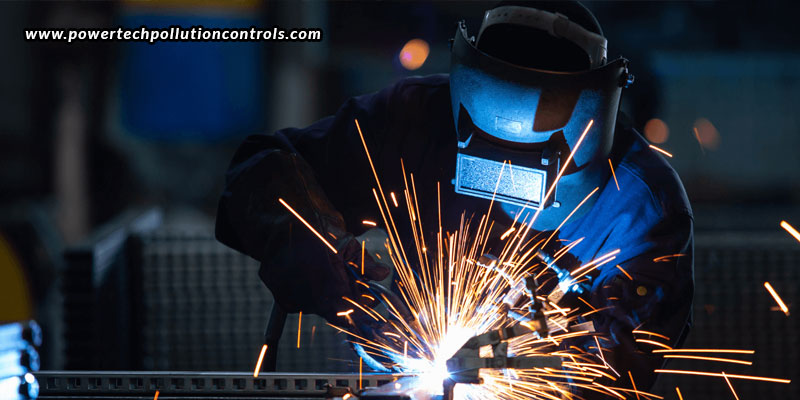
How harmful are welding fumes to one’s health?
Welding procedures can produce a lot of fumes and gases, which may not be noticeable as they typically do not smell awful and are therefore not likely to be deemed intoxicating. But, these fumes are definitely intoxicating for the body even though the nose is not affected. They may also have an impact on the respiratory system, and cause skin allergies and also a variety of cancers! Yes, the contaminants in the fumes are so tiny that they aren’t visible to the naked eye, but they can easily enter the nose and travel to the lungs, from where they may then target other human organs and systems. This is why it is crucial to capture and remove these fumes from the area before anyone nearby inhales them.
Why are welding fume extractors necessary?
In an educational setting, it is the duty of the teachers to address any harm that welding fumes may cause, while also educating the students of the risks involved. To protect their hands and eyes while performing the processes, students are typically instructed to wear safety equipment such as leather gloves, gauntlets, safety glasses with side shields, welders’ goggles, and welders’ helmet. Nevertheless, what about the microscopic invisible toxins that enter the nose and gradually harm the body from within!? It is crucial to install welding fume extractors at each location where welding activities are carried out in order to tackle this problem. The Fumekiller from Powertech Pollution Controls is one promising welding fume extractor. The company has been providing leading companies in the nation like Toyota, Suzuki, HAL, Bharat Electronics, TVS, Wipro, and many others with not only their welding fume extractors, but also a variety of other products like soldering fume extractors, mist collectors, dust collectors, and more; thus making it a trusted partner.
The responsibility of welding instructors and students
To achieve the highest levels of safety, welding teachers and students should take the initiative to follow the right protocols while welding. In addition to the welding techniques being taught, it is the obligation of the educators to make sure that students are instructed on welding hazards, safety laws and regulations, and that they also take the necessary safeguards. Likewise, it is the students’ responsibility to follow the safety instructions given to them, adhere to the laws governing safety, learn how to use the equipment properly, and protect themselves with the appropriate safety equipment.
The health concerns that welding fumes pose extend beyond just the conditions outlined above. Many other things, such as electric shock, fire, explosion, extreme heat, asphyxia, flying sparks, and electric and magnetic fields, are also possible outcomes of these gases. To avoid any risks, mishaps, or injuries in the classroom, welding schools must thus adhere to all local, state, and federal regulations.
-
3 Best Practices For Oil Mist Collector Systems
Oil mist systems are a great tool for reducing the levels of oil mist generated in an industrial setting, which can otherwise be very harmful to the health of the workers within the premises. Such systems are also helpful to improve the reliability of any equipment they are used in conjunction with. Oil mist systems are wonderful ways to deal with the harmful oil mist as they tend to require only a small amount of maintenance and inspection, thus cutting down on a lot of hassle out of any operation that utilizes them. However, all this is possible only when you install an apt oil mist system, one that is high on quality and performance. For instance, the Mistkiller by Powertech Pollution Controls is a high-efficiency trademarked centrifugal oil mist collector that is designed and developed for the control of most types of mist, generated by the use of water-based coolants or water-based liquids. Other than the product itself, there are many other considerations you need to make while installing your oil mist system, some of the best practices to be followed mentioned below.
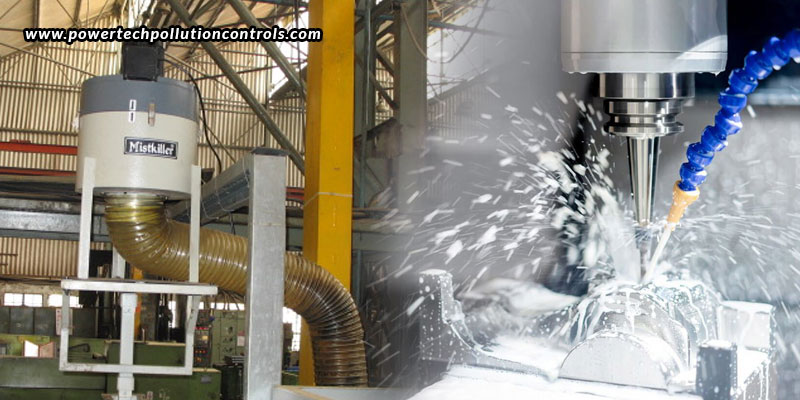
Choosing the appropriate oil mist system
Ideally, the oil droplets generated range between 1 to 3 microns, and have an oil-to-air ratio in the region of 1:2,00,000. The oil mist collectors thus need to operate in the range of under one pound per square inch, and should have a low velocity so that the droplets are unable to collide and coalesce into bigger droplets before reaching the lubed components.
Positioning it right
For an oil mist system to work correctly, it must be placed roughly within 600 feet of the process pumps. Also, the primary 50 feet of supply piping needs to be slanted back towards the generator, so that any excess oil will find its way back to the pump, thus decreasing the amount of oil wastage. And, the remaining piping should be either sloped back towards the mist generator or any low areas with a drain port, so that oil can be trapped.
Regular inspection
Choosing the right oil mist collector and positioning it right are only the first steps. Once everything is up and running, you shouldn’t consider everything done. Instead, you’ll need to ascertain that regular inspection and checks are done to ensure that everything continues to function at its optimum capacity. Some of the main elements to check for regularly and thoroughly include the air filter, regulator, separator, air heater, oil reservoir, and the fittings. It is a good idea to get a qualified professionals, with enough experience in dealing with oil mist systems, to perform the regular checks and inspections. And, in between such professional checks, it is also vital that you, on your part, regularly check the air filters and air separators, and make sure they are kept clean at all times, so that regular clean supply of air can be pumped.
With the right oil mist collector installed, and the above best practices followed, you should be good to go!
Visit our website: https://www.powertechpollutioncontrols.com/
-
Before Buying A Welding Fume Extractor
Welding fume extractor is an important part of every welding operations premises. With welding comes a high concentration of welding fumes, which can prove to be extremely hazardous. An extractor in place can help remove these fumes before they start influencing the workers around.
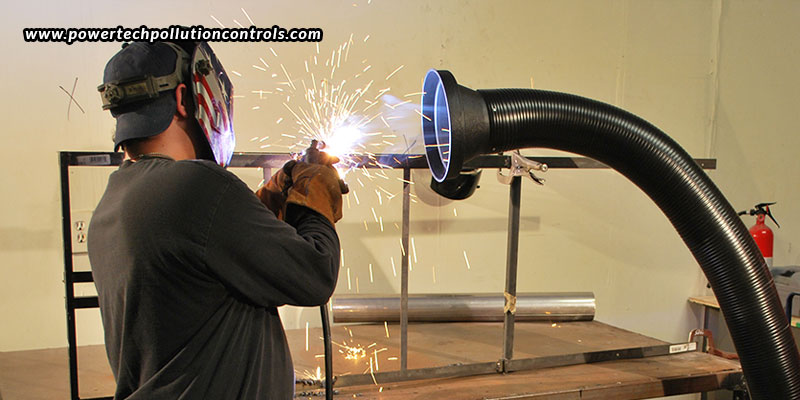
A welding fume extractor is considered efficient when it is capable of removing all kinds of fumes as well as the smallest of particles, while improving the indoor air quality and working as an equipment to protect everyone within the premises. Choosing one such efficient fume extractor is important, which can be based on your requirement, from light to moderate to extensive usage. You can also choose between a stationary fume extractor and a portable fume extractor, depending upon your workspace and operations.
The best welding fume extractor will contain the following features –
Extraction power
The energy efficiency and extraction power need to be adequate. The hazardous fumes and other components need to be immediately removed from the workplace, channelled into the pipe system, and expelled out, or suitably filtered to recirculate clean air within the premises.
High air filtration efficiency
You need to choose a welding fume extractor that has a high rate of suction airflow and purifying efficiency. This is mainly recommended for repair shops that work in rigid climates. The efficient filers should be suited to the dust concentration that characterizes the fumes generated.
Less maintenance and durability
The welding fume extractor should be easy to operate, as well as be very low on maintenance, with low system costs. Also, when required, there should be hassle-free replacement and cleaning of the filters. Changing the filters is a process that typically needs to be done once a year, for the equipment to maintain its full capacity.
Meeting the regulations
Regulations set by various regulatory authorities should be met, to reduce the risk of exposure to hazardous fumes. If the kinds of hazardous fumes aren’t taken care of, it can severely impact the health of everyone within the premises, leading to skin infections, eye irritations, throat irritations, respiratory tract disorders, and even cancer of various organs within the body! Indian regulations that are set for such equipment are more supportive of the prevention of any such risk caused by industries.
You can see how it is important to select the best welding fume extractor for your application. The fume extractor you choose should be best adept to your needs. Also, the capacity of the fume extractor will depend upon how big your facility or workshop is. Whatever the size and type, make sure to buy one that is easy to use, durable, efficient, and cost-effective. For instance, you can opt for Powertech Pollution Controls’ Fumekiller, which is a high-efficiency two-stage electrostatic precipitator that is designed and developed to capture and control not only fumes, but also mist, smoke, and fine dust; thus proving to be the most reliable welding fume extractor India. Moreover, this particular equipment comes with filter modules that are many times washable and re-usable during the life of the equipment. Also, there are many safety features incorporated, such as limit switches, motor protection, and high voltage fault trip circuity, which ensure safe, reliable, and efficient functioning. All in all, with the Fumekiller, you’ll have a safer and healthier work environment, where every possible toxic airborne pollutant is removed.
Visit our website: https://www.powertechpollutioncontrols.com/
-
Subscribe
Subscribed
Already have a WordPress.com account? Log in now.